Improving the Yield and Quality of Morchella spp. Using Agricultural Waste
Abstract
1. Introduction
2. Materials and Methods
2.1. Experimental Design and Sample Collection
2.2. Agronomic Characteristics Test of Fruiting Bodies
2.3. Test of Physiochemical Properties of Cultivation Soils
2.4. Microbial Diversity Test
2.5. Data Analysis and Visualization
3. Results
3.1. Effects of Different Additives on the Yield and Quality of Morchella spp.
3.2. Effects of Substrate Types on Soil Physiochemical Properties for Morchella spp. Culture
3.3. Bacterial Community Analysis in Cultivation Soils with Different Additives
3.3.1. Bacterial Diversity in Cultivation Soils
3.3.2. Species Composition Analyses on the Phylum and Genus Levels in Cultivation Soils
3.3.3. Analysis of Bacterial Community Differences Among Cultivation Soils with Different Additives
3.3.4. Prediction of Potential Functions of Bacteria in Cultivation Soils with Different Additives
3.3.5. Correlation Analysis Between Yield and Quality of Fruiting Bodies and Key Bacteria
3.4. Fungi Community Analysis in Cultivation Soils with Different Additives
3.4.1. Fungal Diversity of Cultivation Soils
3.4.2. Species Composition Analyses at a Fungal Phylum and Genus Level in Cultivation Soils
3.4.3. Analysis of Fungal Community Differences Among Cultivation Soils with Different Additives
3.4.4. Prediction of Potential Functions of Fungi in Cultivation Soil with Different Additives
3.4.5. Correlation Analysis Between Yield and Quality of Fruiting Bodies and Key Fungi
4. Discussion
4.1. Effects of Agricultural Waste on the Yield and Quality of Morchella spp.
4.2. Effects of Agricultural Waste on the Physiochemical Properties of Cultivation Soil
4.3. Effects of Agricultural Waste on Bacteria in Cultivation Soil and Correlation Analysis of Physiochemical Factors
4.4. Effects of Agricultural Waste on Fungi in Cultivation Soil and Correlation Analysis of Physiochemical Factors
4.5. Effects of Soil Physiochemical Properties and Key Microorganisms on the Yield and Quality of Morchella spp.
5. Conclusions
Author Contributions
Funding
Institutional Review Board Statement
Informed Consent Statement
Data Availability Statement
Conflicts of Interest
References
- Du, X.H.; Zhao, Q.; Yang, Z.L. Diversity, evolutionary history and cultivation of morels: A review. Mycosystema 2014, 33, 183–197. [Google Scholar]
- Jin, L.S.; Zhang, R.; Liu, Y.P.; Lv, B.Y. Research progress on chemical composition and pharmacological effects of Morchella spp. Spec. Wild Econ. Anim. Plant Res. 2025, 47, 161–166. [Google Scholar] [CrossRef]
- Dai, Y.C. New trends in the research and development of edible and medicinal fungi in China: An analysis of papers published in Mycosystema from 2000 to 2021. J. Fungal Res. 2022, 20, 141–156. [Google Scholar] [CrossRef]
- Tian, F.; Gao, X.L.; Li, B.; Gao, H.P. Causes and control of continuous cropping obstacles in Morchella spp. Rural. Sci. Technol. 2020, 11, 91–92. [Google Scholar]
- Li, Y.J.; Lin, J.F.; Xin, X.F.; Wang, K.Y.; Tian, S.B.; Ding, J.Y.; Tan, X.; Lin, G.Y.; Zhang, Y.H.; Wang, G.J.; et al. Research progress on soilless cultivation technology of facility tomatoes in China. China Fruits Veg. 2022, 42, 61–65. [Google Scholar] [CrossRef]
- Jiang, W.J. Study on Nutritional Physiology and Optimized Fertilization of Organic Soilless Cultivated Tomatoes. Ph.D. Dissertation, Chinese Academy of Agricultural Sciences, Beijing, China, 2007. [Google Scholar]
- Sun, H.B.; Zhang, B.X.; Li, N.; Geng, B. Research and discussion on key technical measures for soilless cultivation of tomatoes. Bull. Agric. Sci. Technol. 2018, 9, 311–314. [Google Scholar]
- Peng, L.P. Reuse of edible fungus residues and future utilization directions. Ind. Microbiol. 2023, 53, 40–42. [Google Scholar]
- Wang, S.R.; Liu, G.F.; Zhao, G.H. Investigation on Morchella resources and ecological environment in Heze Yellow River alluvial plain. Edible Fungi China 2008, 6, 12–14. [Google Scholar]
- Chen, X.H. Screening of cultivation substrates for Morchella sextelata. J. Fujian For. Sci. Technol. 2020, 47, 85–88. [Google Scholar] [CrossRef]
- Song, W.; Wang, X.; Ma, Y.M.; Zhang, Y.P.; Wang, F. Effects of different substrates on soil physicochemical properties and microbial diversity in Morchella cultivation. J. Shanxi Agric. Sci. 2022, 50, 378–385. [Google Scholar]
- Shen, T.; Du, J.; Li, M.L.; Zhao, S.W.; Ma, J.; Qin, W.L. Effects of different cultivation substrates on yield and nutrient composition of Morchella spp. Bull. Soil Water Conserv. 2021, 41, 187–192. [Google Scholar] [CrossRef]
- Yu, F.M.; Jayawardena, R.S.; Thongklang, N.; Lv, M.L.; Zhu, X.T.; Zhao, Q. Morel production associated with soil nitrogen-fixing and nitrifying microorganisms. J. Fungi 2022, 8, 299. [Google Scholar] [CrossRef] [PubMed]
- Zhang, C.; Shi, X.F.; Zhang, J.X.; Zhang, Y.S.; Wang, W. Dynamics of soil microbiome throughout the cultivation life cycle of morel (Morchella sextelata). Front. Microbiol. 2023, 14, 979835. [Google Scholar] [CrossRef] [PubMed]
- Zou, G.H.; Zhao, F.L.; Lan, X.C.; Wu, T.H. Effects of coconut shell biochar application on soil enzyme activity and microbial community in paddy fields under different water conditions. Soil 2024, 56, 525–532. [Google Scholar] [CrossRef]
- Zhang, X.F.; Yang, X.R.; Jiao, Z.W. Analysis of functional diversity of rhizosphere soil microorganisms in wild Morchella from Yili. J. Microbiol. 2019, 39, 83–89. [Google Scholar]
- Xiong, C.; Li, X.L.; Li, Q.; Zheng, L.Y. Structure and diversity of bacterial communities in Morchella sclerotial soil. J. Hunan Agric. Univ. (Nat. Sci.) 2015, 41, 428–434. [Google Scholar]
- Benucci, G.M.N.; Longley, R.; Zhang, P.; Zhao, Q.; Bonito, G.; Yu, F. Microbial communities associated with the black morel Morchella sextelata cultivated in greenhouses. PeerJ 2019, 7, e7744. [Google Scholar] [CrossRef]
- Yang, S.; Ding, L.; Wu, W.N.; Hu, S.H.; Guo, J. Common diseases and pests in Morchella cultivation and their control measures. Edible Fungi 2024, 46, 69–73. [Google Scholar]
- NY/T 1121.6-2006; Soil Testing—Part 6: Method for Determination of Soil Organic Matter. China Agriculture Press: Beijing, China, 2006.
- LY/T 1237-1999; Determination of Forest Soil Organic Matter and Calculation of Carbon to Nitrogen Ratio. Standards Press of China: Beijing, China, 1999.
- Guo, Y.; Zheng, A.B.; Zhong, E.R. Reuse of Lentinula edodes residues. Mod. Agric. 2017, 12, 36–37. [Google Scholar]
- He, R.F. Comprehensive utilization of edible fungus by-products. Appl. Technol. Mark. 1989, 6, 20–21. [Google Scholar]
- Guo, H.Y.; Wang, T.; Hu, H.P.; Jiang, M. Research progress on edible fungi enriched with trace elements. Edible Fungi China 2022, 41, 1–8. [Google Scholar]
- Fu, T.T. Effects of Plastic Film Mulching and Straw Returning on Soil Carbohydrates in Farmland. Master’s Thesis, Lanzhou University, Lanzhou, China, 2015. [Google Scholar]
- Li, C.H.; Pan, Y.K.; Wang, Q.; Bellick, M.; Wang, X.Y. Study on the changes of main nutrients in substrates during the cultivation of Auricularia auricula-judae using Ganoderma lucidum residues. Mod. Agric. Res. 2018, 3, 5–8. [Google Scholar] [CrossRef]
- He, Y. Edible fungi: Indispensable functional food. Farmers’ Dly. 2014, 2, T01. [Google Scholar]
- Chen, M.; Tao, H.; Li, L.; Lu, W.; Wang, F. Effects of different cultivation materials on nutritional quality of Agaricus bisporus. Chin. Agric. Sci. Bull. 2011, 27, 266–269. [Google Scholar]
- Chen, W.; Wu, J.; Li, X.; Lu, J.; Wu, W.; Sun, Y.; Zhu, B.; Qin, L. Isolation, structural properties, bioactivities of polysaccharides from Dendrobium officinale Kimura et. Migo: A review. Int. J. Biol. Macromol. 2021, 184, 1000–1013. [Google Scholar] [CrossRef] [PubMed]
- Yang, W.J.; Jin, Q.L.; Wu, H.B.; Hu, J.L.; Zhou, H.Y. Key technologies for indoor cultivation of Morchella spp. Edible Med. Mushrooms 2024, 32, 211–216. [Google Scholar]
- Bhatti, A.A.; Haq, S.; Bhat, R.A. Actinomycetes benefaction role in soil and plant health. Microb. Pathog. 2017, 111, 458–467. [Google Scholar] [CrossRef]
- Lan, J.; Wang, S.; Long, Q.; Wang, J.; Qi, X.; Huang, M.; Liu, L.; Yue, K. The influence of afforestation on soil bacterial community composition in karst rocky desertification areas of Guizhou Province, China. Res. Sq. 2024. [Google Scholar] [CrossRef]
- Rivas, R.; Velázquez, E.; Willems, A.; Vizcaíno, N.; Subba-Rao, N.S.; Mateos, P.F.; Gillis, M.; Dazzo, F.B.; Martínez-Molina, E. A new species of Devosia that forms a unique nitrogen-fixing root-nodule symbiosis with the aquatic legume Neptunia natans. Appl. Environ. Microbiol. 2002, 68, 5217–5222. [Google Scholar] [CrossRef]
- Zhang, Y.; Sun, S.; Luo, D.; Mao, P.; Rosazlina, R.; Martin, F.; Xu, L. Decline in morel production upon continuous cropping is related to changes in soil mycobiome. J. Fungi 2023, 9, 492. [Google Scholar] [CrossRef]
- Cheng, C.; Li, Q.; Wang, J.; Fu, R.T.; Jin, X.; Xiong, C.; Lu, D.H. Effect of Morchella stem rot on soil fungal community structure. J. Microbiol. 2018, 38, 39–45. [Google Scholar]
- Li, X.S.; Sun, D.F.; Hua, R.; Li, J.Y.; Yue, W.S.; Liu, S.X. Analysis of pathogenic microorganism diversity in continuous cropping obstacle soil of Morchella spp. Edible Fungi China 2024, 43, 96–106. [Google Scholar] [CrossRef]
- Wang, B.X. Identification of Pathogenic Fungi and Preliminary Study on Biological Control in Morchella Cultivation. Master’s Thesis, China West Normal University, Nanchong, China, 2021. [Google Scholar]
- Fu, B.; Wang, J.Z.; Li, Y.M.; Zhang, S.L.; Hao, Z.; Zhang, F. Isolation, identification, and biological characteristics of pathogenic fungi causing Morchella fungal wilt. Acta Agric. Boreali-Occident. Sin. 2022, 31, 640–647. [Google Scholar]
- Pan, Y.Q.; Li, Y.X.; Chen, J.X.; Lv, Z.J.; Wu, J.R.; Ma, H.C. Investigation and pathogen identification of diseases in artificially cultivated Morchella in Lijiang. Guizhou Agric. Sci. 2021, 49, 67–74. [Google Scholar]
- Song, J.Z.; Yu, J.R.; Xia, G.Q.; Qin, G.M.; Yang, Y.F. Correlation analysis between wild Morchella and soil composition in Changbai Mountain area. Jiangsu Agric. Sci. 2016, 44, 258–260. [Google Scholar] [CrossRef]
- Zhang, S.; Liu, T.; He, M.; Zhang, S.; Liao, J.; Lei, T.; Wu, X.; Yu, Y.; Wang, T.; Tan, H. A nationwide study of heavy metal(loid)s in agricultural soils and the soil-grown black morel Morchella sextelata in China. J. Environ. Manag. 2024, 369, 122243. [Google Scholar] [CrossRef]
- Xiao, Q.M.; Zhang, M.; Zhang, J.J.; Wang, X.L. A Compound Microbial Agent and Bio-Organic Fertilizer for Promoting the Growth of Morchella esculenta. China Patent CN108485995A, 4 September 2018. [Google Scholar]
- Niu, N.; Guo, J.X.; Qi, X.G.; Liu, X.F.; Chen, J.F. Research progress on comprehensive application of edible fungus residues. North. Hortic. 2023, 20, 130–136. [Google Scholar]

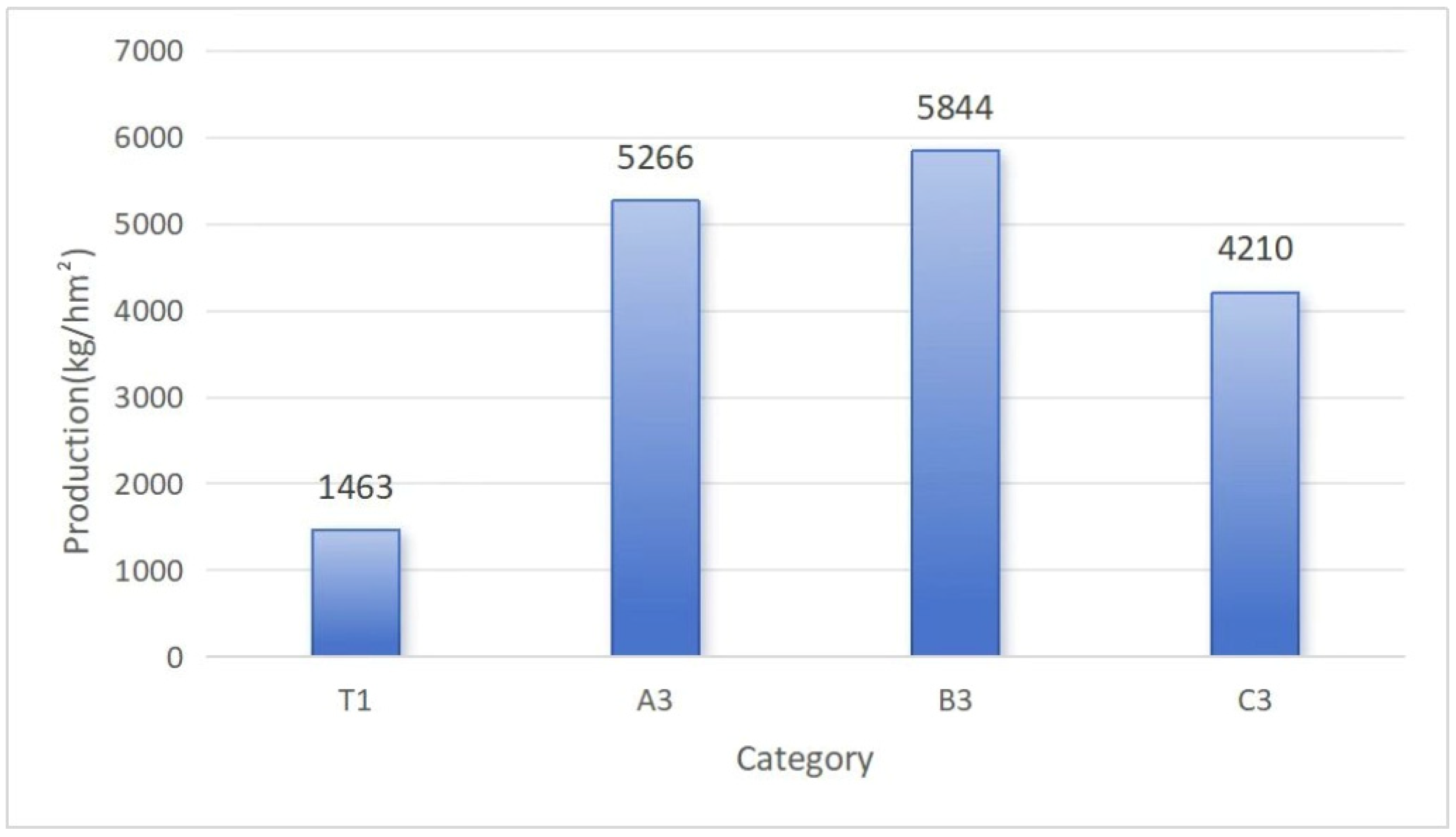
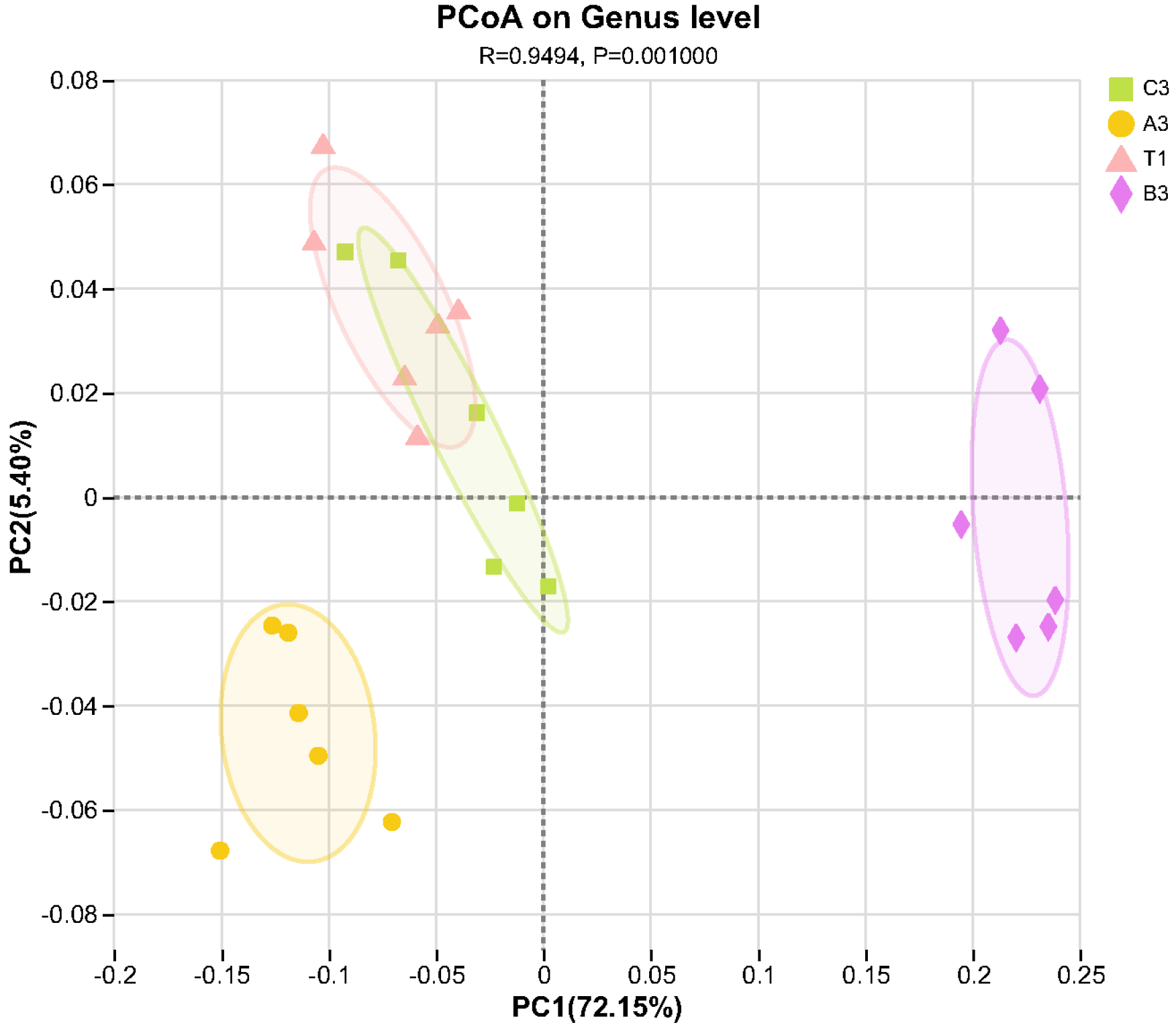
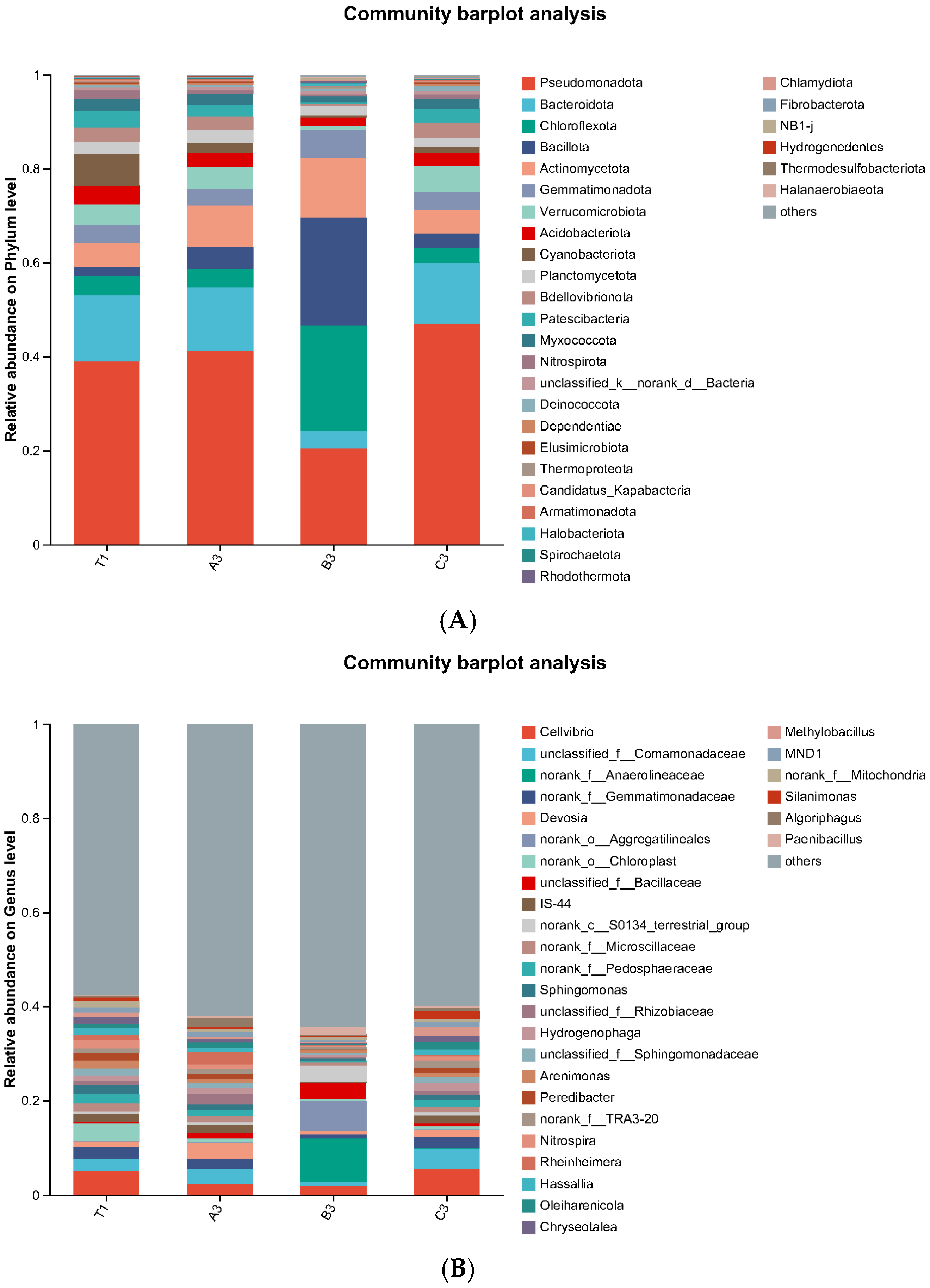
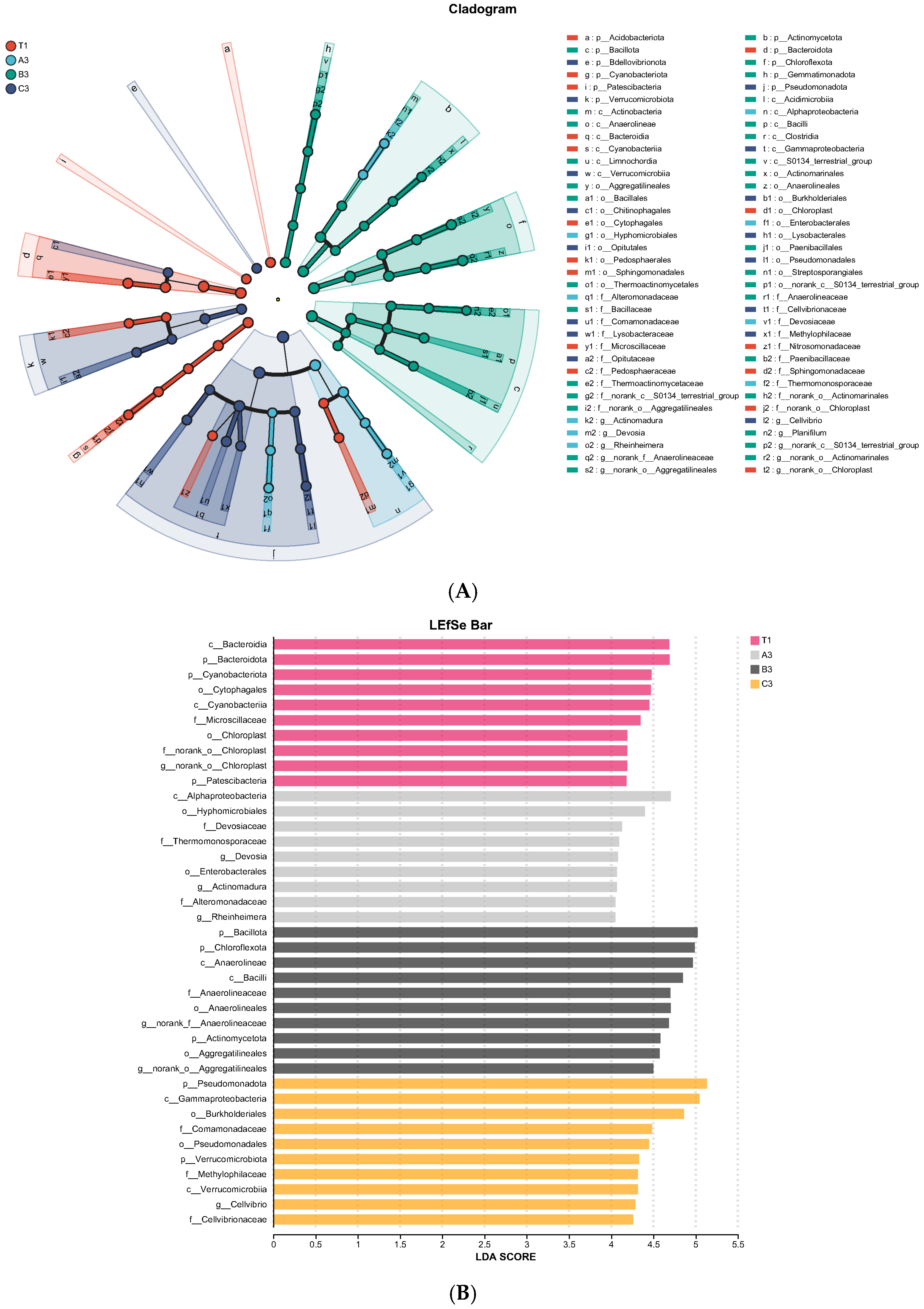

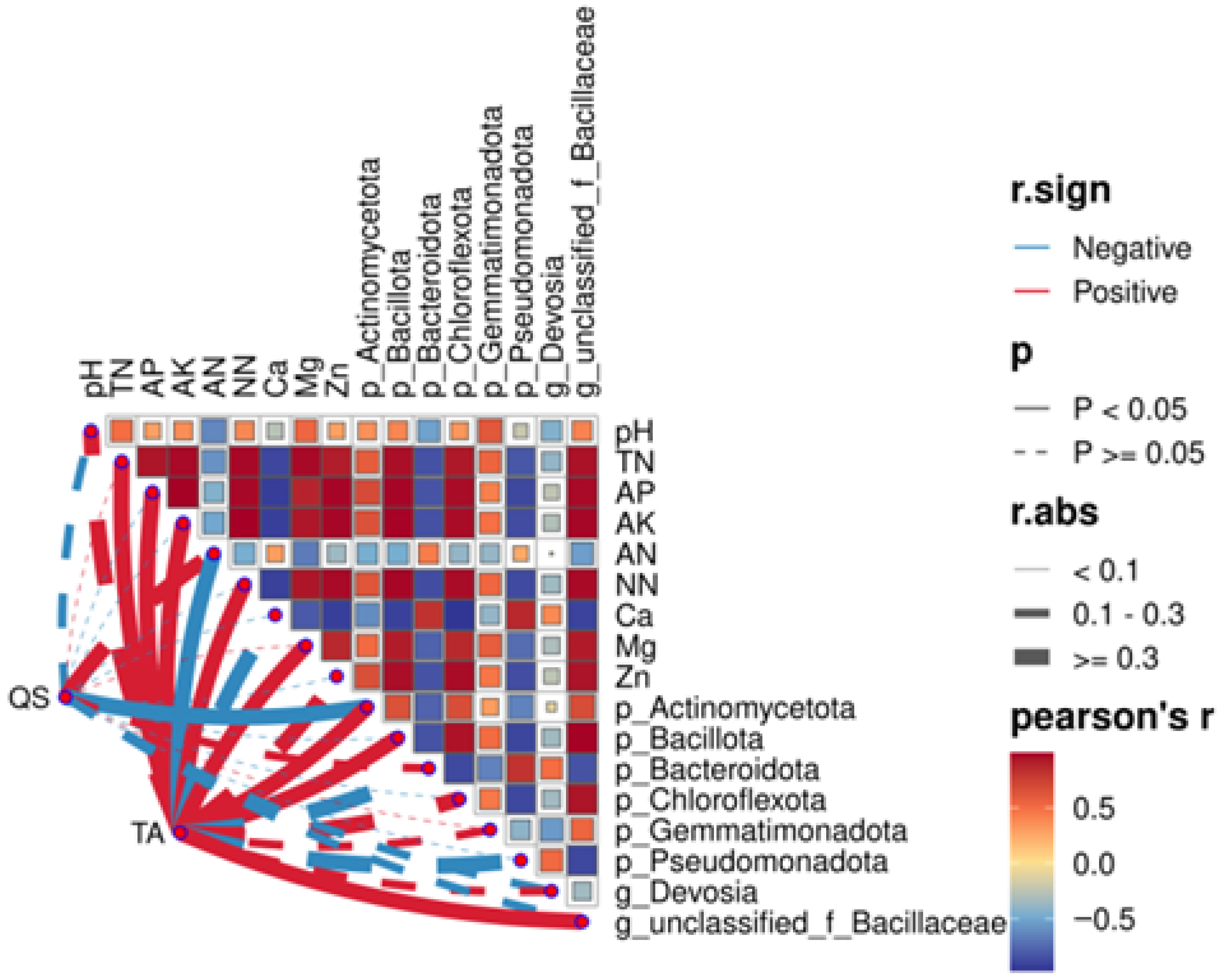
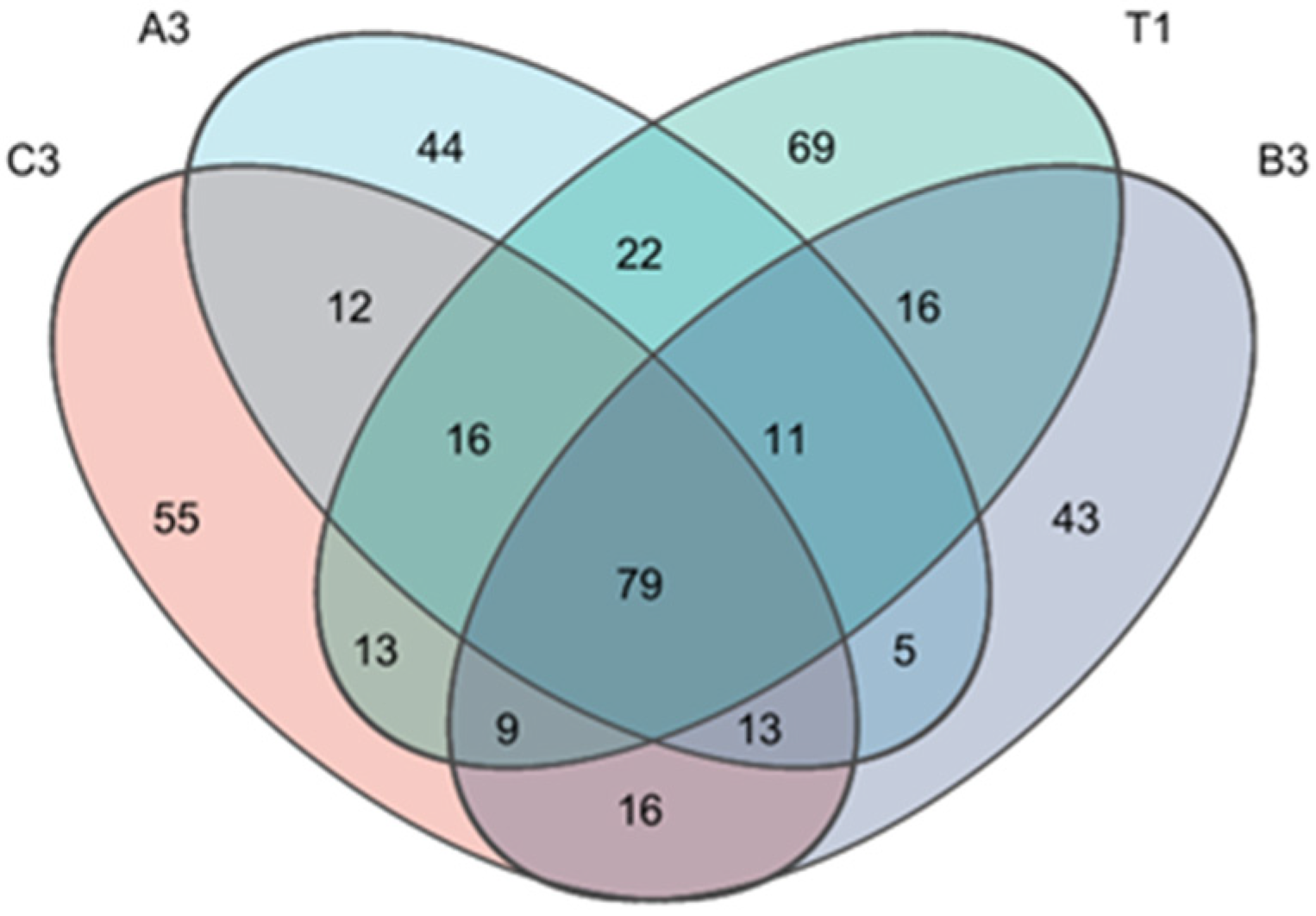
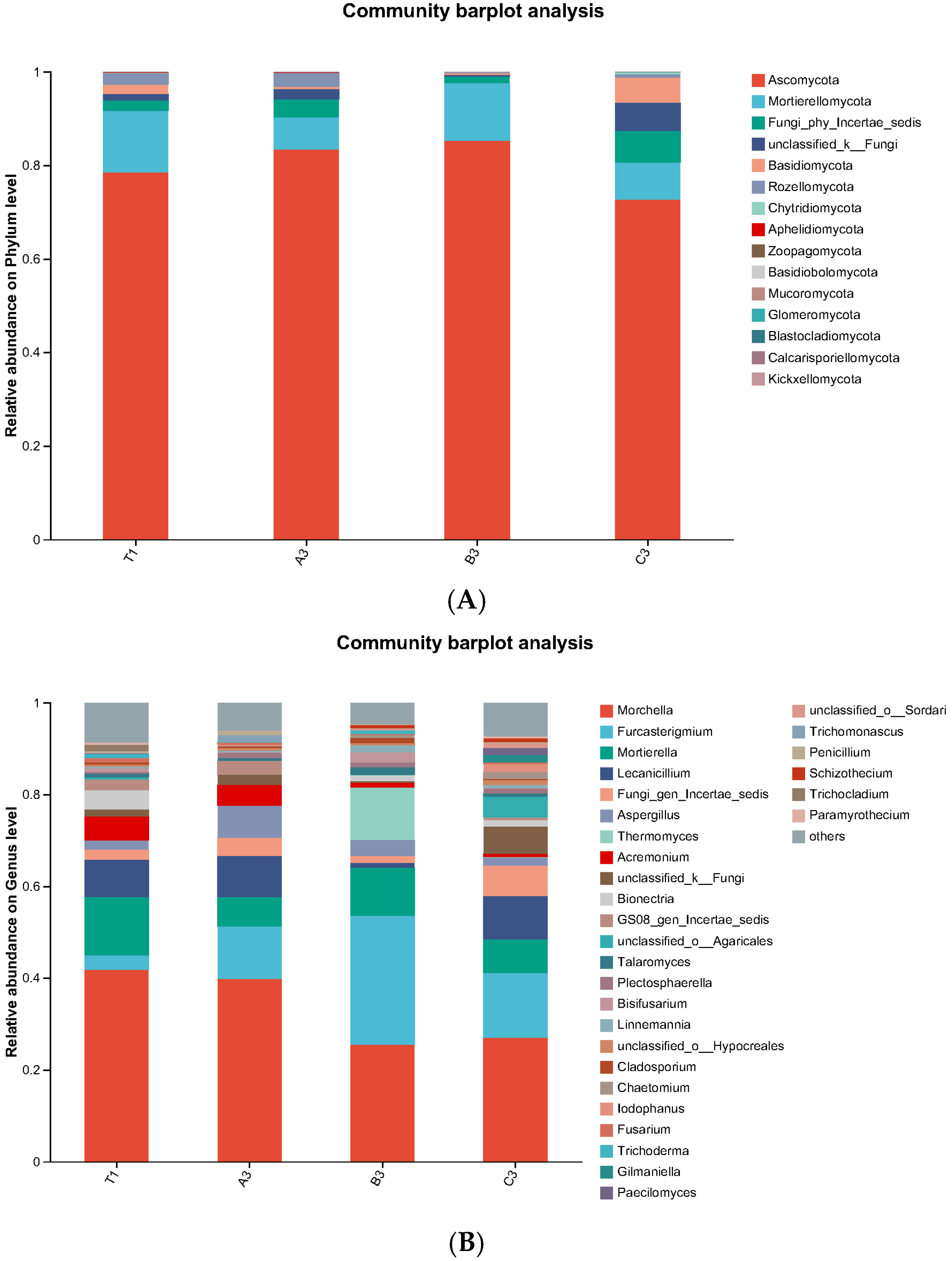
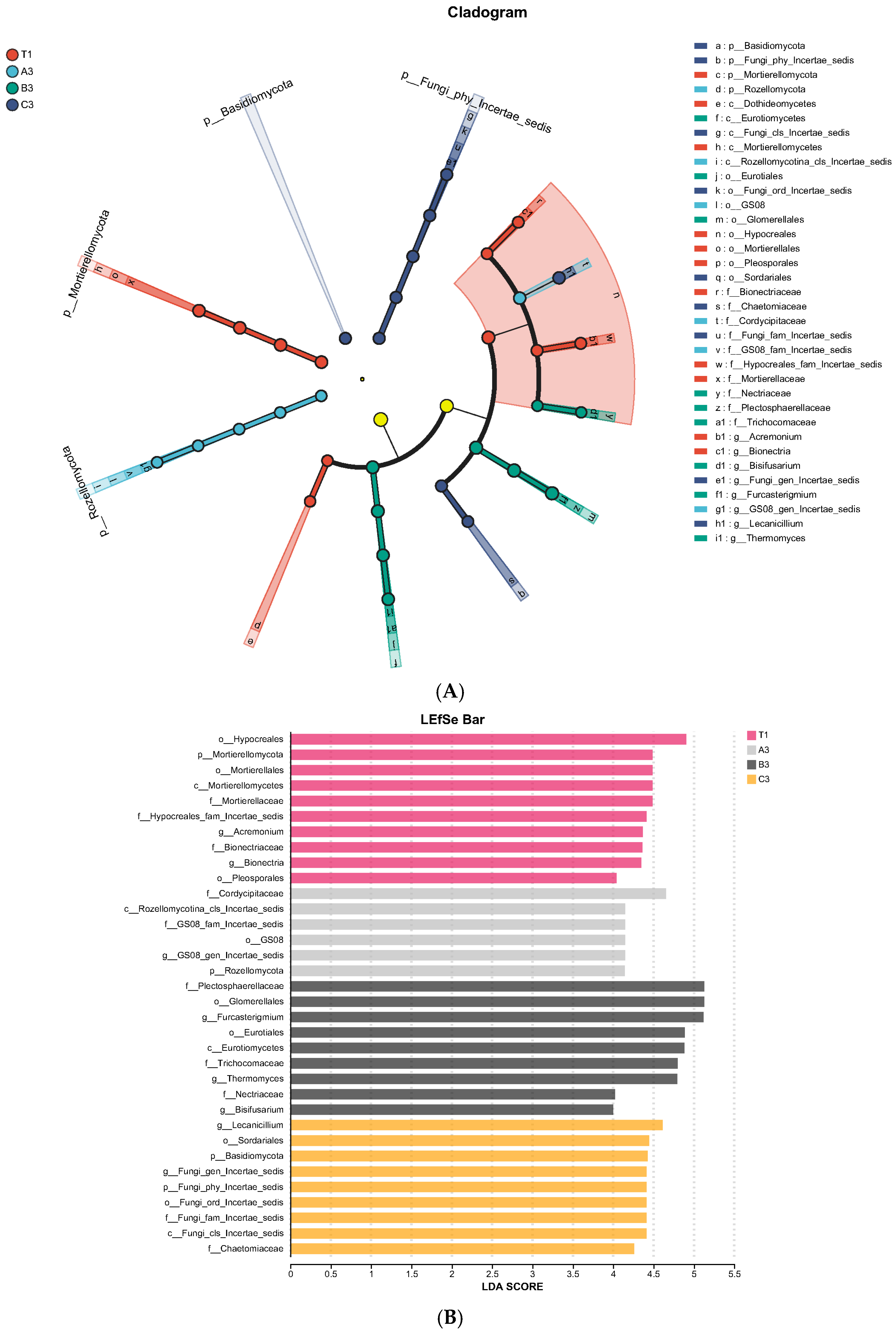

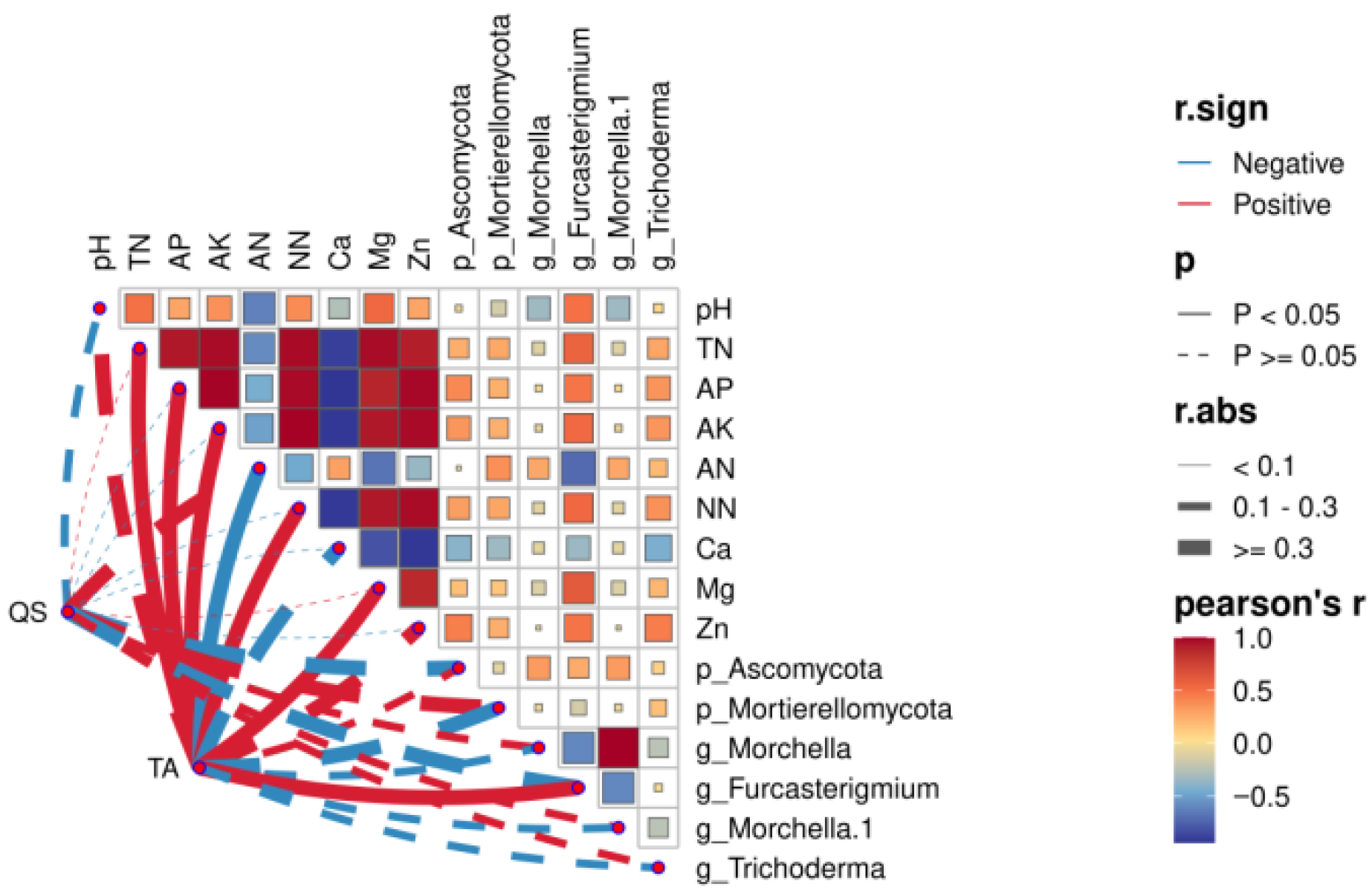
| Sequencing Region | Primer Name | Primer Sequence (5′→3′) |
|---|---|---|
| ITS1F_ITS2R | ITS1F | CTTGGTCATTTAGAGGAAGTAA |
| ITS2R | GCTGCGTTCTTCATCGATGC | |
| ArBa515F_806R | ArBa515F | GTGCCAGCMGCCGCGGTAA |
| 806R | GGACTACHVGGGTWTCTAAT |
| Groups | Polysaccharides | Crude Protein | Total Potassium Ion | Crude Fat | Crude Fibre | Water Content |
|---|---|---|---|---|---|---|
| g/kg | g/100 g | g/100 g | g/100 g | g/100 g | g/100 g | |
| T1 | 30.08 ± 0.62 c | 43.19 ± 0.04 a | 3.43 ± 0.03 d | 2.44 ± 0.07 a | 20.24 ± 0.94 a | 89.17 ± 0.17 c |
| A3 | 32.83 ± 1.18 b | 42.21 ± 0.07 b | 3.62 ± 0.02 b | 2.13 ± 0.04 c | 17.00 ± 0.76 b | 90.38 ± 0.26 b |
| B3 | 43.62 ± 0.65 a | 43.23 ± 0.04 a | 3.54 ± 0.01 c | 2.26 ± 0.06 b | 16.34 ± 0.32 b | 87.66 ± 0.23 d |
| C3 | 33.55 ± 1.08 b | 41.52 ± 0.04 c | 3.90 ± 0.01 a | 2.12 ± 0.07 c | 17.07 ± 1.27 b | 91.59 ± 0.06 a |
| Groups | Water Content | pH | TN | AP | AK | Ammonium Nitrogen | Nitrate Nitrogen | Exchangeable Calcium | Exchangeable Magnesium | Available Zinc |
|---|---|---|---|---|---|---|---|---|---|---|
| % | Dimensionless | g/kg | mg/kg | mg/kg | mg/kg | mg/kg | Cmol/kg | Cmol/kg | mg/kg | |
| T1 | 24.65 ± 0.07 d | 8.12 ± 0.07 b | 0.68 ± 0.02 d | 17.28 ± 0.65 c | 254.52 ± 3.45 d | 13.62 ± 0.16 a | 10.60 ± 0.64 c | 9.48 ± 0.22 a | 1.04 ± 0.01 d | 1.67 ± 0.05 b |
| A3 | 31.85 ± 0.03 a | 8.16 ± 0.07 b | 0.70 ± 0.02 c | 20.04 ± 0.40 b | 323.01 ± 2.86 b | 7.29 ± 0.14 b | 11.04 ± 0.85 bc | 9.51 ± 0.21 a | 1.12 ± 0.04 c | 1.68 ± 0.03 b |
| B3 | 27.31 ± 0.19 c | 8.27 ± 0.04 a | 1.03 ± 0.01 a | 38.99 ± 0.69 a | 960.46 ± 8.67 a | 5.29 ± 0.12 c | 36.49 ± 3.10 a | 8.63 ± 0.16 b | 1.53 ± 0.03 a | 2.30 ± 0.07 a |
| C3 | 29.46 ± 0.10 b | 8.30 ± 0.04 a | 0.77 ± 0.02 b | 16.65 ± 0.40 c | 316.07 ± 2.62 c | 5.13 ± 0.16 d | 13.00 ± 0.77 b | 9.67 ± 0.28 a | 1.23 ± 0.04 b | 1.59 ± 0.02 c |
Disclaimer/Publisher’s Note: The statements, opinions and data contained in all publications are solely those of the individual author(s) and contributor(s) and not of MDPI and/or the editor(s). MDPI and/or the editor(s) disclaim responsibility for any injury to people or property resulting from any ideas, methods, instructions or products referred to in the content. |
© 2025 by the authors. Licensee MDPI, Basel, Switzerland. This article is an open access article distributed under the terms and conditions of the Creative Commons Attribution (CC BY) license (https://creativecommons.org/licenses/by/4.0/).
Share and Cite
Wang, J.; Cai, W.; Jin, Q.; Fan, L.; Guo, Z.; Feng, W. Improving the Yield and Quality of Morchella spp. Using Agricultural Waste. J. Fungi 2025, 11, 703. https://doi.org/10.3390/jof11100703
Wang J, Cai W, Jin Q, Fan L, Guo Z, Feng W. Improving the Yield and Quality of Morchella spp. Using Agricultural Waste. Journal of Fungi. 2025; 11(10):703. https://doi.org/10.3390/jof11100703
Chicago/Turabian StyleWang, Jiawen, Weiming Cai, Qunli Jin, Lijun Fan, Zier Guo, and Weilin Feng. 2025. "Improving the Yield and Quality of Morchella spp. Using Agricultural Waste" Journal of Fungi 11, no. 10: 703. https://doi.org/10.3390/jof11100703
APA StyleWang, J., Cai, W., Jin, Q., Fan, L., Guo, Z., & Feng, W. (2025). Improving the Yield and Quality of Morchella spp. Using Agricultural Waste. Journal of Fungi, 11(10), 703. https://doi.org/10.3390/jof11100703






